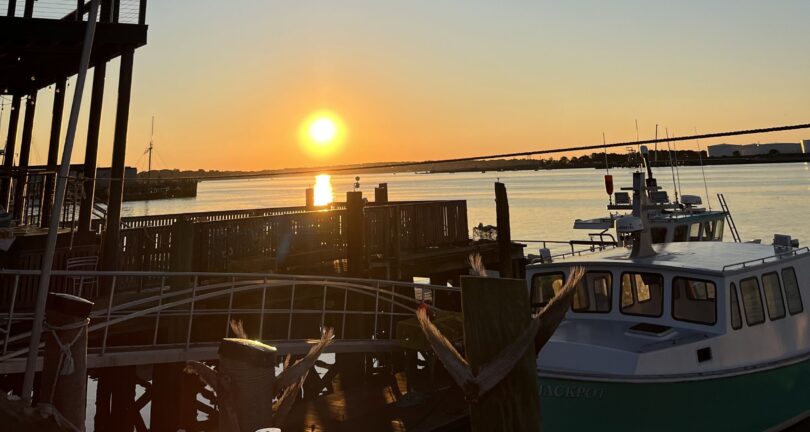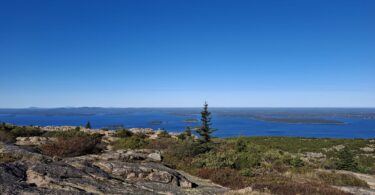Casco Bay, Maine, U.S.A. – I rise before dawn, wolf down my bowl of cereal and hop in the car. After a peaceful one-hour drive, I arrive at the Portland Pier. The air feels moist and smells like fresh salt. Getting out of my car, I am hit by the rising sun’s rays. Seagulls squawk all around me.
Listen to the author read this story:
At the bait shack, I put on my lobstering gear, which smells like yesterday’s haul with a hint of fish and rubber mixed in. There are rubber boots, waders, a rain coat, rubber gloves and a lifejacket.
At the dock, where I meet the rest of the crew of the Sea Smoke, I hear the waves sloshing and the boats rocking on the ocean.
My lobstering day on Casco Bay has begun.
Lift All Boats
The crew consists of me, four other students from the program, and a captain. Members of the crew rotate, and the captains are our instructors. We’re all part of Lift All Boats, an internship program that brings together Maine college and high school students of color and teaches them how to gain skills at lobstering.

Students in the program work on a lobster boat in the summer, in hopes they will consider a career related to the sea. I’ve learned a lot from the captains, Wiley Muller, Ben Conniff and Miranda Shinn, who instilled in me a joy of working on the ocean. Because of this experience, I may pursue a career on the water.
In the winter of 2022, one of the captains, Wiley Muller, was my high school engineering teacher. One day at the end of class, he came up to me and told me that he was working with Lift All Boats and invited me to apply. I climbed aboard the Sea Smoke for the first time in 2023.

A day on the water
A regular day on the Sea Smoke starts with untying it from the Portland Pier dock and getting bait and fuel. Following that, we start making bait bags for our lobster traps.
We head out into the bay to check the traps, which are between Long Island and Peaks Island. The traps are on the sea floor, under a buoy, which is a floating marker in the water with a distinctive coloring. Aboard the Sea Smoke, there is a GPS device that we use to mark buoy location and other bits of information.
We paint our buoys in colors of our choice so we can easily identify them among many in the water.

To get my buoy out of the water, I take a wooden tool called the gaff and grab it. Once I hook the buoy – which is attached to my trap by a piece of rope – I put the buoy in a machine called the hauler. It pulls up my trap from the ocean floor onto the boat. Once the trap is on the boat, I open it and take out any lobsters.
I measure them to see if the lobsters are legal in size to keep. They have to be between three to five inches from their back to the top of their heads.
Next I band the lobsters with rubber bands around their claws, and put them in a saltwater tank to keep them alive. I put the lobsters that are not legal – because they are pregnant, too small or too big to keep – back in the ocean.
I put a new bait bag in the empty trap. Once I’m all done with the trap, I close it up, and I flake, or coil, the rope attached to the buoy back onto the trap, so it is ready to be pushed back into the water.

The crew will repeat this process until everyone has hauled up their 20 traps onto the boat. After that, the crew gets ready to reset our traps, making sure that the trap is in good condition and that everything in it functions. We also ensure that our state tags, which allow us to fish, are in our traps.
We prepare the bait bags for the traps by setting pieces of fresh fish that the lobster will eat into a bag that goes into the trap.
Then the captain calls out a number that’s written on our buoy. The captain will yell: “Set it!” It’s the crew’s job to push that numbered trap into the water. After everybody’s traps are back in the water, reset and rebaited, we have to clean and rinse down the entire boat with soap and water.
Once that’s done, we head back to land to sell our lobsters to the Cape Seafood market. Finally, we take off our gear. It’s noon.


Above, at left, one day’s catch. Image by Carlos Fra-Nero/YJI. At right, the author prepares to weigh and sell his catch. (Photo provided. Used with permission.)
Science and the sea
Something I enjoy about the program is how marine policy and marine biology are incorporated into the work. For instance, we need to know how to gender a lobster.
One of the ways lobster men and lobster women figure out whether a lobster is male or female is by looking at its swimmerets. Swimmerets are little limbs that all lobsters have to help with reproduction. When you flip a lobster on its back, you can see the swimmerets located under its legs.
Female lobsters have thin, soft and feathery swimmerets, while male lobsters have big, tough, bonelike swimmerets. In addition to their lessons about lobster anatomy on the Sea Smoke, the captains also teach us about the lobster’s environment.

For example, we collect data from placing our traps and seeing what spots in the ocean lobsters like. Lobsters prefer areas in the water that are rocky, cool, and rich in kelp, or water vegetation.
I just finished my third year with Lift All Boats. This job is community based, science based, and hands-on.
When lobstering, working with a crew makes everything go by much faster, and it is safer. There are a lot of moving parts to the lobstering process: driving the boat, hauling lobster traps and setting them.

Lift All Boats has given me the opportunity to meet a lot of new people who, by the end of the day, become good friends. The camaraderie in this program is a beautiful thing and one of the reasons I have enjoyed it so much.
Working with Lift All Boats has been an experience that I will forever hold close to my heart. I am grateful to have met all these incredible people, from students to staff. They have shown and taught me a lot about building community and working on the water.
Along with other advanced students, I got to fish into the fall this year. I’ll be back again in June, ready to set my traps and get back out on the water.
Carlos Fra-Nero is a Reporter with Youth Journalism International.



